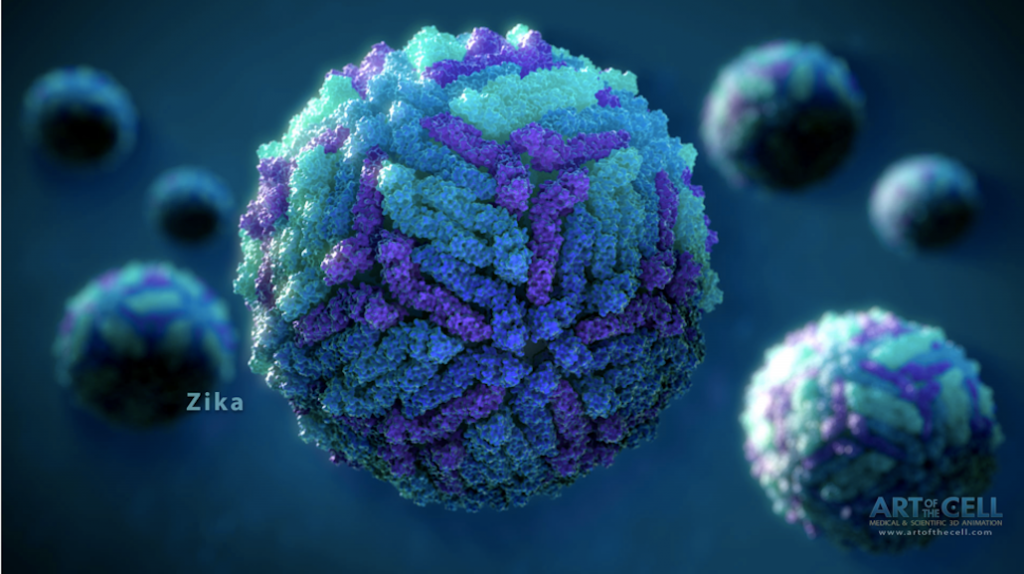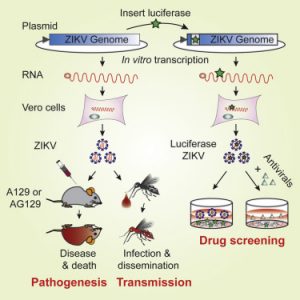Review article: Zika Virus
This review describes the current understanding of the epidemiology, transmission, clinical characteristics, and diagnosis of Zika virus infection, as well as the future outlook with regard to this disease.
This review describes the current understanding of the epidemiology, transmission, clinical characteristics, and diagnosis of Zika virus infection, as well as the future outlook with regard to this disease.
Poucas pessoas tinham ouvido falar do vírus Zika antes de 2015, quando ele começou a se espalhar rapidamente nas Américas, particularmente no Brasil. O vírus é transmitido principalmente por mosquitos, embora a transmissão sexual e pelo sangue também sejam possíveis. Algumas mulheres grávidas que contraíram o vírus Zika deram à luz a crianças com uma doença chamada microcefalia, que resulta em graves problemas no desenvolvimento cerebral. Em outros casos, adultos e crianças que contraíram o vírus Zika sofreram paralisia e outros problemas neurológicos.
Atualmente, não existe nenhum tratamento ou vacina para o vírus Zika. Dado que o Zika se tornou rapidamente uma preocupação de saúde pública internacional, minha equipe e eu estamos trabalhando com pesquisadores aqui no Brasil, bem como nos Estados Unidos, para procurar possíveis tratamentos, e nós estamos usando o World Community Grid para acelerar nosso projeto.

Virologists from KU Leuven, Belgium, have shown that an experimental antiviral drug against hepatitis C slows down the development of Zika in mice. The research team was led by Professor Johan Neyts from the Laboratory of Virology and Chemotherapy.
“The Zika virus is transmitted by the tiger mosquito. Roughly twenty percent of the people who are infected actually get sick,” explains Professor Neyts. “The most common symptoms, which last about a week, are fever, fatigue, joint and muscle pain, rash, and red eyes. A small number of infected people go on to develop Guillain-Barré Syndrome, which causes muscle weakness and temporary paralysis. In some cases, the patient needs to be put on a ventilator.”
The Zika virus could spread to Europe this summer, although the likelihood of an outbreak is low to moderate, the World Health Organization has said. Areas most at risk are those where Aedes mosquitoes may spread the virus, like the Black Sea coast of Russia and Georgia and the island of Madeira. Countries with a moderate risk include France, Spain, Italy and Greece, while the risk in the UK is low. The UN agency is not issuing any new travel advice at this time.

We report an infectious cDNA clone of ZIKV that was generated using a clinical isolate of the Asian lineage. The cDNA clone-derived RNA is infectious in cells, generating recombinant ZIKV. The recombinant virus is virulent in established ZIKV mouse models, leading to neurological signs relevant to human disease. Additionally, recombinant ZIKV is infectious for Aedes aegypti and thus provides a means to examine virus transmission. The infectious cDNA clone was further used to generate a luciferase ZIKV that exhibited sensitivity to a panflavivirus inhibitor, highlighting its potential utility for antiviral screening. This ZIKV reverse genetic system, together with mouse and mosquito infection models, may help identify viral determinants of human virulence and mosquito transmission as well as inform vaccine and therapeutic strategies.

Here we report the crystal structure of ZIKV helicase NS3 at 1.8-Å resolution. The helicase structure revealed a conserved triphosphate pocket critical for nonspecific hydrolysis of nucleoside triphosphates across multiple flavivirus species. A positive-charged tunnel has been identified in the viral helicase, which is potentially responsible for accommodating the RNA. This crystal structure of ZIKV helicase provides an accurate model for rational drug design against ZIKV infection.
Combined proteomics and mRNA transcriptional profile analyses showed that Brazilian ZIKV, prior to induce cell death, alters cell cycle and halts neurogenic programmes, in addition to regulate transcription and protein translation due to viral replication. These results point to biological mechanisms potentially implicated in brain malformations as a result of ZIKV congenital infection.
Acesso grátis à pesquisa médica, ferramentas online e aconselhamento especializado sobre o vírus Zika.
Essa página irá fornecer continuamente recursos atualizados do conteúdo e dos especialistas da Elsevier, incluindo da The Lancet e do especialista em doenças infecciosas mundialmente conhecido, Dr. Raphael Dolin.
Publicado em 13 de abril de 2016.

Acesso grátis à pesquisa médica, ferramentas online e aconselhamento especializado sobre o vírus Zika
A trio of mouse studies published today (May 11) provides some of the strongest evidence yet that Zika virus infection can cause birth defects. Researchers at the University of São Paulo in Brazil and their colleagues reported in Nature that the Brazilian strain of the virus could cross the placentas of pregnant mice, resulting in microcephaly in developing embryos. Meanwhile, researchers from the Chinese Academy of Sciences reported similar findings in Cell Stem Cell after having studied a different infection route. And researchers at the Washington University School of Medicine in St. Louis found that Zika can infect pregnant, immune-deficient mice and their fetuses, causing restricted growth and fetal death; their findings were published in Cell.
Three studies show that the virus can cause birth defects in mouse embryos.
By Tanya Lewis | May 11, 2016
NIH-Funded Scientists Detail Tissue Destruction Caused by Zika Virus During Pregnancy.
For Immediate Release: Wednesday, May 11, 2016

